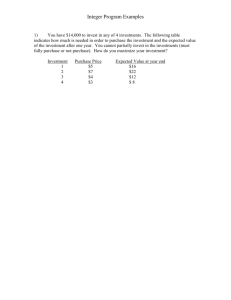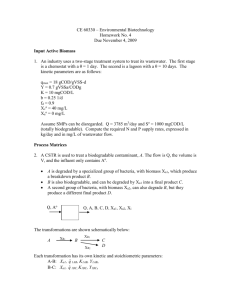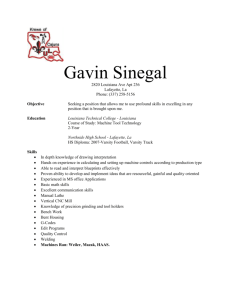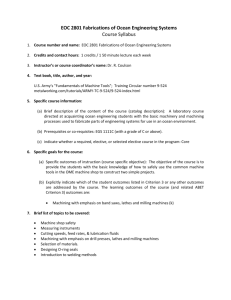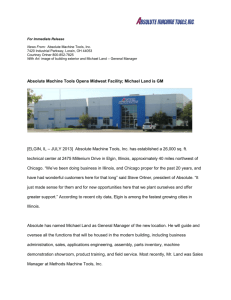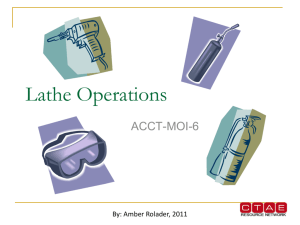Module 5 (ppt file)
advertisement
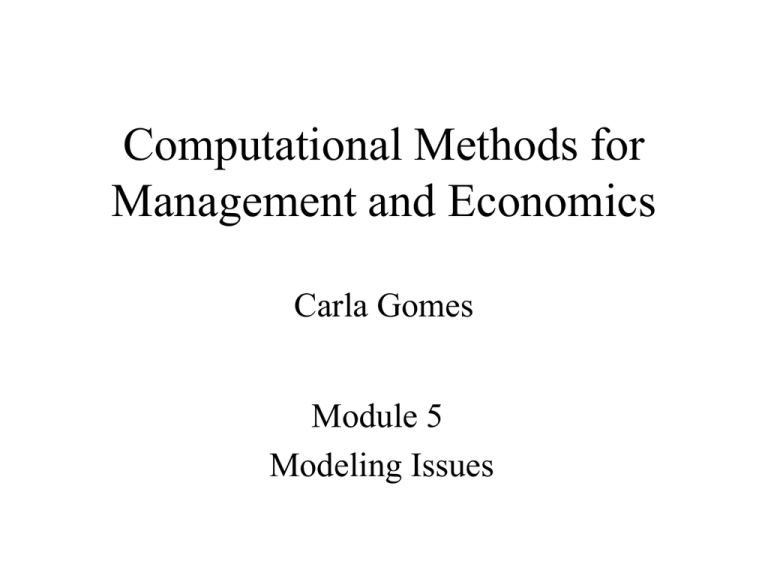
Computational Methods for Management and Economics Carla Gomes Module 5 Modeling Issues Main Categories of LP problems: Resource-Allocation Problems Cost-benefit-trade-off problems Distribution-Network Problems Resource Allocation Problem Wyndor Glass • Resources – m (plants) • Activities – n (2 products) • Wyndor Glass problem optimal product mix --allocation of resources to activities i.e., choose the levels of the activities that achieve best overall measure of performance Financial Planning • Another area of application of resource-allocation problems Financial Planning • Resources: – Financial assets (cash, securities,accounts receivable, lines of credit, etc). • Example: Capital budgeting – Resources: amounts of investment capital available at different points in time. Think-Big Capital Budgeting Problem • Think-Big Development Co. is a major investor in commercial real-estate development projects. • They are considering three large construction projects – Construct a high-rise office building. – Construct a hotel. – Construct a shopping center. • Each project requires each partner to make four investments at four different points in time for the corresponding share: a down payment now, and additional capital after one, two, and three years. Financial Data for the Projects Amount Investment Capital Requirements Year Available Office Building Hotel Shopping Cente 0 1 2 $25 million $40 million $80 million $90 million $20 million 60 million 80 million 50 million $20 million 90 million 80 million 20 million 3 $15 million 10 million 70 million 60 million $45 million $70 million $50 million Net present value Net present value - discounted future cash outflows (capital invested) and cash inflows (income) and adding discounted net cash flows • Thus a partner taking a certain percentage share of a project is obligated to invest that percentage of each the amounts for each point in time. Question: At what fraction should ThinkBig invest in each of the three projects? • Activities: Activity 1 – invest in construction of office building Activity 2 – invest in construction of hotel Activity 3 – invest in construction of shopping center Decisions – level for each activity • Resources: Resource 1 – total investment capital available now Resource 2 – cumulative investment capital available by the end of one year. Resource 3– cumulative investment capital available by the end of two years. Resource 4– cumulative investment capital available by the end of three years. Cumulative Investment Capital Required for an entire Project Amount Investment Capital Requirements Year Available Office Building Hotel Shopping Cente 0 1 2 $25 million $40 million $80 million $90 million $45 million 100 million 160 million 140 million $65 million 190 million 240 million 160 million 3 $80 million 200 million 310 million 220 million $45 million $70 million $50 million Net present value Net present value - discounted future cash outflows (capital invested) and cash inflows (income) and adding discounted net cash flows Algebraic Formulation Let OB = Participation share in the office building, H = Participation share in the hotel, SC = Participation share in the shopping center. Maximize NPV = 45OB + 70H + 50SC subject to Total invested now: 40OB + 80H + 90SC ≤ 25 ($million) Total invested within 1 year: 100OB + 160H + 140SC ≤ 45 ($million) Total invested within 2 years: 190OB + 240H + 160SC ≤ 65 ($million) Total invested within 3 years: 200OB + 310H + 220SC ≤ 80 ($million) and OB ≥ 0, H ≥ 0, SC ≥ 0. Cost-benefit-trade-off problems Cost-benefit-trade-off problems The mix of levels of various activities is chosen to achieve minimum acceptable levels for various benefits at a minimum cost. The Profit & Gambit Co. (Hillier & Hillier): • Management has decided to undertake a major advertising campaign that will focus on the following three key products: – A spray prewash stain remover. – A liquid laundry detergent. – A powder laundry detergent. • The campaign will use both television and print media • The general goal is to increase sales of these products. • Management has set the following goals for the campaign: – Sales of the stain remover should increase by at least 3%. – Sales of the liquid detergent should increase by at least 18%. – Sales of the powder detergent should increase by at least 4%. Question: how much should they advertise in each medium to meet the sales goals at a minimum total cost? Profit & Gambit Co. Data Profit & Gambit Co. Advertising-Mix Problem Unit Cost ($millions) Stain Remover Liquid Detergent Powder Detergent Television 1 Print Media 2 Increase in Sales per Unit of Advertising (%) 0 1 3 2 -1 0 Minimum Increase 3 18 4 • Activity 1 – advertise on television • Activity 2 – advertise in the print media • Benefit 1 – increases sales of stain remover • Benefit 2 – increases sales of liquid detergent • Benefit 3 – increases sales of powder detergent Algebraic Model for Profit & Gambit Let TV = the number of units of advertising on television PM = the number of units of advertising in the print media Minimize Cost = TV + 2PM (in millions of dollars) subject to Stain remover increased sales: PM ≥ 3 Liquid detergent increased sales: 3TV + 2PM ≥ 18 Powder detergent increased sales: –TV + 4PM ≥ 4 and TV ≥ 0, PM ≥ 0. Applying the Graphical Method Amount of print media advertising PM Feasible 10 region 8 6 4 PM = 3 2 -TV + 4 PM = 4 -4 -2 0 2 3 TV + 2 PM = 18 4 6 Amount of TV advertising 8 10 TV The Optimal Solution PM 10 Feasible region Cost = 15 = TV + 2 PM Cost = 10 = TV + 2 PM 4 (4,3) optimal solution 0 5 10 Amount of TV advertising 15 TV Summary of the Graphical Method • Draw the constraint boundary line for each constraint. Use the origin (or any point not on the line) to determine which side of the line is permitted by the constraint. • Find the feasible region by determining where all constraints are satisfied simultaneously. • Determine the slope of one objective function line. All other objective function lines will have the same slope. • Move a straight edge with this slope through the feasible region in the direction of improving values of the objective function. Stop at the last instant that the straight edge still passes through a point in the feasible region. This line given by the straight edge is the optimal objective function line. • A feasible point on the optimal objective function line is an optimal solution. Union Airways Personnel Scheduling • Union Airways is adding more flights to and from its hub airport and so needs to hire additional customer service agents. • The five authorized eight-hour shifts are – – – – – Shift 1: 6:00 AM to 2:00 PM Shift 2: 8:00 AM to 4:00 PM Shift 3: Noon to 8:00 PM Shift 4: 4:00 PM to midnight Shift 5: 10:00 PM to 6:00 AM Question: How many agents should be assigned to each shift? Time Periods Covered by Shift Time Period 1 6 AM to 8 AM √ 8 AM to 10 AM √ √ 79 10 AM to noon √ √ 65 Noon to 2 PM √ √ √ 87 √ √ 64 2 PM to 4 PM 2 3 4 5 Minimum Number of Agents Needed 48 4 PM to 6 PM √ √ 73 6 PM to 8 PM √ √ 82 8 PM to 10 PM √ 43 10 PM to midnight √ Midnight to 6 AM Daily cost per agent √ 52 √ 15 $170 $160 $175 $180 $195 LP Formulation Let Si = Number working shift i (for i = 1 to 5), Minimize Cost = $170S1 + $160S2 + $175S3 + $180S4 + $195S5 subject to Total agents 6AM–8AM: S1 ≥ 48 Total agents 8AM–10AM: S1 + S2 ≥ 79 Total agents 10AM–12PM: S1 + S2 ≥ 65 Total agents 12PM–2PM: S1 + S2 + S3 ≥ 87 Total agents 2PM–4PM: S2 + S3 ≥ 64 Total agents 4PM–6PM: S3 + S4 ≥ 73 Total agents 6PM–8PM: S3 + S4 ≥ 82 Total agents 8PM–10PM: S4 ≥ 43 Total agents 10PM–12AM: S4 + S5 ≥ 52 Total agents 12AM–6AM: S5 ≥ 15 and Si ≥ 0 (for i = 1 to 5) Work-scheduling problem A Work-Scheduling Problem (from Intro Math Programming Winston & Venkataramanan) A post office requires different numbers of full-time employees on different days of the week. Union rules state that each full-time employee must work five consecutive days and then receive two days off. For example, an employee who works on Monday to Friday must be off on Saturday and Sunday. The post office wants to meet its daily requirements using only full-time employees. Overview • Work-scheduling problem – The model – Practical enhancements or modifications – Two non-linear objectives that can be made linear – A non-linear constraint that can be made linear These slides are adapted from James Orlin’s Scheduling Postal Workers • Each postal worker works for 5 consecutive days, followed by 2 days off, repeated weekly. Day Demand Mon Tues Wed Thurs Fri 17 13 15 19 14 Sat Sun 16 11 • Minimize the number of postal workers (for the time being, we will permit fractional workers on each day.) What’s wrong with this formulation? Minimize z = x1 + x2 + x3 + x4 + x5 + x6 + x7 subject to x1 17 x2 13 •Decision variables –Let x1 be the number of workers who work on Monday x3 15 x4 19 x5 14 –Let x2 be the number of workers who work on Tuesday … –Let x3, x4, …, x7 be defined similarly. x6 16 x7 11 xj 0 for j = 1 to 7 Day Demand Mon Tues Wed Thurs Fri 17 13 15 19 14 Sat Sun 16 11 Answer • Objective function is not number of fulltime post office employees each employee is counted five times; • The variables x1, x2, x3, etc are interrelated but that is not captured in our formulation (for example some people who are working on Monday are also working on Tuesday) LP Formulation • Select the decision variables – Let x1 be the number of workers who start working on Monday, and work till Friday – Let x2 be the number of workers who start on Tuesday … – Let x3, x4, …, x7 be defined similarly. Note 1: number of full-time employees is x1 + x2 + x3 + x 4 + x5 + x6 + x7 Note 2: Who is working on Monday? Everybody except those who start working on Tuesday and Wednesday (on Monday they have a day off) (similarly reasoning can be applied for the other days) Day Demand Mon Tues Wed Thurs Fri Sat The13linear program 15 19 14 16 17 Minimize z = x1 + x2 + x3 + x4 + x5 + x6 + x7 subject to x1 + x1 + x2 + x4 + x5 + x6 + x7 17 x5 + x6 + x7 13 x1 + x2 + x3 + x6 + x7 x1 + x2 + x3 + x4 + x7 x1 + x2 + x3 + x4 + x5 x2 + x3 + x4 + x5 + x6 15 19 14 16 x3 + x4 + x5 + x6 + x7 11 xj 0 for j = 1 to 7 Sun 11 Some Enhancements of the Model • Suppose that there was a pay differential. The cost of workers who start work on day j is cj per worker. Minimize z = c1 x1 + c2 x2 + c3 x3 + … + c7 x7 Some Enhancements of the Model • Suppose that one can hire part time workers (one day at a time), and that the cost of a part time worker on day j is PTj. • Let yj = number of part time workers on day j What is the Revised Linear Program? Minimize z = x1 + x2 + x3 + x4 + x5 + x6 + x7 subject to x4 + x5 + x6 + x7 x5 + x6 + x7 17 13 x1 + x2 + x3 + x6 + x7 x1 + x2 + x3 + x4 + x7 x1 + x2 + x3 + x4 + x5 x2 + x3 + x4 + x5 + x6 15 19 14 16 x3 + x4 + x5 + x6 + x7 11 x1 + x1 + x2 + xj 0 for j = 1 to 7 Minimize z = x1 + x2 + x3 + x4 + x5 + x6 + x7 + PT1 y1 + PT2 y2 + … + PT7 y7 subject to x1 + x4 + x5 + x6 + x7 + y1 17 x1 + x2 + x5 + x6 + x7 + y2 13 x1 + x2 + x3 + x6 + x7 + y3 15 x1 + x2 + x3 + x4 + x7 + y4 19 x1 + x2 + x3 + x4 + x5 + y5 14 x2 + x3 + x4 + x5 + x6 + y6 16 x3 + x4 + x5 + x6 + x7 + y7 11 xj 0 , yj 0 for j = 1 to 7 Another Enhancement • Suppose that the number of workers required on day j is dj. Let yj be the number of workers on day j. • What is the minimum cost schedule, where the “cost” of having too many workers on day j is fj(yj – dj), which is a non-linear function? • NOTE: this will lead to a non-linear program, not a linear program. • We will let sj = yj – dj be the excess number of workers on day j. What is the Revised Linear Program? Minimize z = x1 + x2 + x3 + x4 + x5 + x6 + x7 subject to x4 + x5 + x6 + x7 x5 + x6 + x7 17 13 x1 + x2 + x3 + x6 + x7 x1 + x2 + x3 + x4 + x7 x1 + x2 + x3 + x4 + x5 x2 + x3 + x4 + x5 + x6 15 19 14 16 x3 + x4 + x5 + x6 + x7 11 x1 + x1 + x2 + xj 0 for j = 1 to 7 Minimize z = f1(s1) + f2(s2) + f3(s3) + f4(s4) + f5(s5) + f6(s6) + f7(s7) subject to x1 + x4 + x5 + x6 + x7 - s1 = 17 x1 + x2 + x5 + x6 + x7 - s2 = 13 x1 + x2 + x3 + x6 + x7 - s3 = 15 x1 + x2 + x3 + x4 + x7 - s4 = 19 x1 + x2 + x3 + x4 + x5 s5 = 14 x2 + x3 + x4 + x5 + x6 - s6 = 16 x3 + x4 + x5 + x6 + x7 - s7 = 11 xj 0 , sj 0 for j = 1 to 7 A non-linear objective that often can be made linear. Suppose that one wants to minimize the maximum of the slacks, that is minimize z = max (s1, s2, …, s7). This is a non-linear objective. But we can transform it, so the problem becomes an LP. Minimize z z sj subject to for j = 1 to 7. x1 + x4 + x5 + x6 + x7 - s1 x1 + x2 + x5 + x6 + x7 - s2 x1 + x2 + x3 + x6 + x7 - s3 x1 + x2 + x3 + x4 + x7 - s4 x1 + x2 + x3 + x4 + x5 s5 x2 + x3 + x4 + x5 + x6 - s6 x3 + x4 + x5 + x6 + x7 - s7 = 17 = 13 = 15 = 19 = 14 = 16 = 11 xj 0 , sj 0 for j = 1 to 7 The new constraint ensures that z max (s1, …, s7) The objective ensures that z = sj for some j. Another non-linear objective that often can be made linear. Suppose that the “goal” is to have dj workers on day j. Let yj be the number of workers on day j. Suppose that the objective is minimize Si | yj – dj | This is a non-linear objective. But we can transform it, so the problem becomes an LP. Minimize Sj zj zj dj - yj for j = 1 to 7. zj yj - dj subject to for j = 1 to 7. x1 + x4 + x5 + x6 + x7 = y1 x1 + x2 + x5 + x6 + x7 = y2 x1 + x2 + x3 + x6 + x7 = y3 x1 + x2 + x3 + x4 + x7 = y4 x1 + x2 + x3 + x4 + x5 = y5 x2 + x3 + x4 + x5 + x6 = y6 x3 + x4 + x5 + x6 + x7 = y7 xj 0 , yj 0 for j = 1 to 7 The new constraints ensure that zj | yj – dj | for each j. The objective ensures that zj = | yj – dj | for each j. A ratio constraint: Suppose that we need to ensure that at least 30% of the workers have Sunday off. How do we model this? (x1 + x2 )/x1 + x2 + x3 + x4 + x5 + x6 + x7 .3 (x1 + x2 ) .3 x1 + .3 x2 + .3 x3 + .3 x4 + .3 x5 + .3 x6 + .3 x7 -.7 x1 - .7 x2 + .3 x3 + .3 x4 + .3 x5 + .3 x6 + .3 x7 <= 0 Other enhancements • Require that each shift has an integral number of workers – integer program • Consider longer term scheduling – model 6 weeks at a time • Consider shorter term scheduling – model lunch breaks • Model individual workers – permit worker preferences Distribution Network Problems The Big M Distribution-Network Problem • The Big M Company produces a variety of heavy duty machinery at two factories. One of its products is a large turret lathe. • Orders have been received from three customers for the turret lathe. Some Data Shipping Cost for Each Lathe Customer Customer Customer To 1 2 3 From Factory 1 $700 Factory 2 800 Order 10 lathes Size $900 900 $800 700 8 lathes 9 lathes Output 12 lathes 15 lathes The Distribution Network C1 10 lathes needed C2 8 lathes needed C3 9 lathes needed $700/lathe 12 lathe produced F1 $900/lathe $800/lathe $900/lathe $800/lathe 15 lathes produced F2 $700/lathe Question: How many lathes should be shipped from each factory to each customer? • Activities – shipping lanes (not the level of production which has already been defined) – Level of each activity – number of lathes shipped through the corresponding shipping lane. Best mix of shipping amounts Resources requirements from factories and customers. Example: Requirement 1: Factory 1 must ship 12 lathes Requirement 2: Factory 2 must ship 15 lathes Requirement 3: Customer 1 must receive 10 lathes Requirement 4: Customer 2 must receive 8 lathes Requirement 5: Customer 3 must receive 9 lathes Algebraic Formulation Let Sij = Number of lathes to ship from i to j (i = F1, F2; j = C1, C2, C3). Minimize Cost = $700SF1-C1 + $900SF1-C2 + $800SF1-C3 + $800SF2-C1 + $900SF2-C2 + $700SF2-C3 subject to Factory 1: SF1-C1 + SF1-C2 + SF1-C3 = 12 Factory 2: SF2-C1 + SF2-C2 + SF2-C3 = 15 Customer 1: SF1-C1 + SF2-C1 = 10 Customer 2: SF1-C2 + SF2-C2 = 8 Customer 3: SF1-C3 + SF2-C3 = 9 and Sij ≥ 0 (i = F1, F2; j = C1, C2, C3). Summary of Main Categories of LP problems: Resource-Allocation Problems Cost-benefit-trade-off problems Distribution-Network Problems Types of Functional Constraints Type Resource constraint Benefit constraint Fixedrequirement constraint Typical Form* Interpretation Main Usage LHS ≤ RHS For some resource, Amount used ≤ Amount available Resourceallocation problems and mixed problems LHS ≥ RHS For some benefit, Level achieved ≥ Minimum Acceptable Cost-benefittrade-off problems and mixed problems LHS = RHS For some quantity, Amount provided = Required amount Distributionnetwork problems and mixed problems * LHS = Left-hand side RHS = Right-hand side (a constant). Mixed LP problems Save-It Company Waste Reclamation • The Save-It Company operates a reclamation center that collects four types of solid waste materials and then treats them so that they can be amalgamated into a salable product. • Three different grades of product can be made: A, B, and C (depending on the mix of materials used). Question: What quantity of each of the three grades of product should be produced from what quantity of each of the four materials? Product Data for the Save-It Company Amalgamation Cost per Pound Selling Price per Pound A Material 1: Not more than 30% of total Material 2: Not less than 40% of total Material 3: Not more than 50% of total Material 4: Exactly 20% of total $3.00 $8.50 B Material 1: Not more than 50% of total Material 2: Not less than 10% of the total Material 4: Exactly 10% of the total 2.50 7.00 C Material 1: Not more than 70% of the total 2.00 5.50 Grade Specification Material Data for the Save-It Company Material Pounds/Week Available Treatment Cost per Pound 1 3,000 $3.00 2 2,000 6.00 3 4,000 4.00 4 1,000 5.00 Additional Restrictions 1. For each material, at least half of the pounds/week available should be collected and treated. 2. $30,000 per week should be used to treat these materials. Algebraic Formulation Let xij = Pounds of material j allocated to product i per week (i = A, B, C; j = 1, 2, 3, 4). Maximize Profit = 5.5(xA1 + xA2 + xA3 + xA4) + 4.5(xB1 + xB2 + xB3 + xB4) + 3.5(xC1 + xC2 + xC3 + xC4) subject to Mixture Specifications: xA1 ≤ 0.3 (xA1 + xA2 + xA3 + xA4) xA2 ≥ 0.4 (xA1 + xA2 + xA3 + xA4) xA3 ≤ 0.5 (xA1 + xA2 + xA3 + xA4) xA4 = 0.2 (xA1 + xA2 + xA3 + xA4) xB1 ≤ 0.5 (xB1 + xB2 + xB3 + xB4) xB2 ≥ 0.1 (xB1 + xB2 + xB3 + xB4) xB4 = 0.1 (xB1 + xB2 + xB3 + xB4) xC1 ≤ 0.7 (xC1 + xC2 + xC3 + xC4) Availability of Materials: xA1 + xB1 + xC1 ≤ 3,000 xA2 + xB2 + xC2 ≤ 2,000 xA3 + xB3 + xC3 ≤ 4,000 xA4 + xB4 + xC4 ≤ 1,000 Restrictions on amount treated: xA1 + xB1 + xC1 ≥ 1,500 xA2 + xB2 + xC2 ≥ 1,000 xA3 + xB3 + xC3 ≥ 2,000 xA4 + xB4 + xC4 ≥ 500 Restriction on treatment cost: 3(xA1 + xB1 + xC1) + 6(xA2 + xB2 + xC2) + 4(xA3 + xB3 + xC3) + 5(xA4 + xB4 + xC4) = 30,000 and xij ≥ 0 (i = A, B, C; j = 1, 2, 3, 4). Spreadsheet Formulation Unit Amalg. Cost Unit Selling Price Unit Profit Grade A $3.00 $8.50 $5.50 Grade B $2.50 $7.00 $4.50 Grade C $2.00 $5.50 $3.50 Material Allocation (pounds of material used for each product grade) Grade A Grade B Grade C Material 1 412.3 2,587.7 0 Material 2 859.6 517.5 0 Material 3 447.4 1,552.6 0 Material 4 429.8 517.5 0 Total Products 2,149.1 5,175.4 0 Total Profit $35,110 Total Treatment Cost Treatment Funds Available Unit Treament Cost $3 $6 $4 $5 Minimum to Treat 1,500 1,000 2,000 500 Mixture Specifications Grade A, Material 1 412.3 Grade A, Material 2 859.6 Grade A, Material 3 447.4 Grade A, Material 4 429.8 <= <= <= <= $30,000 = $30,000 Total Material Treated 3,000 1,377 2,000 947 <= >= <= = 644.7 859.6 1,074.6 429.8 <= <= <= <= Amount Available 3,000 2,000 4,000 1,000 Mixture Percents 30% of 40% of 50% of 20% of Grade Grade Grade Grade A A A A Grade B, Material 1 Grade B, Material 2 Grade B, Material 4 2,587.7 517.5 517.5 <= >= = 2,587.7 517.5 517.5 50% 10% 10% of Grade B of Grade B of Grade B Grade C, Material 1 0.0 <= 0.0 70% of Grade C
